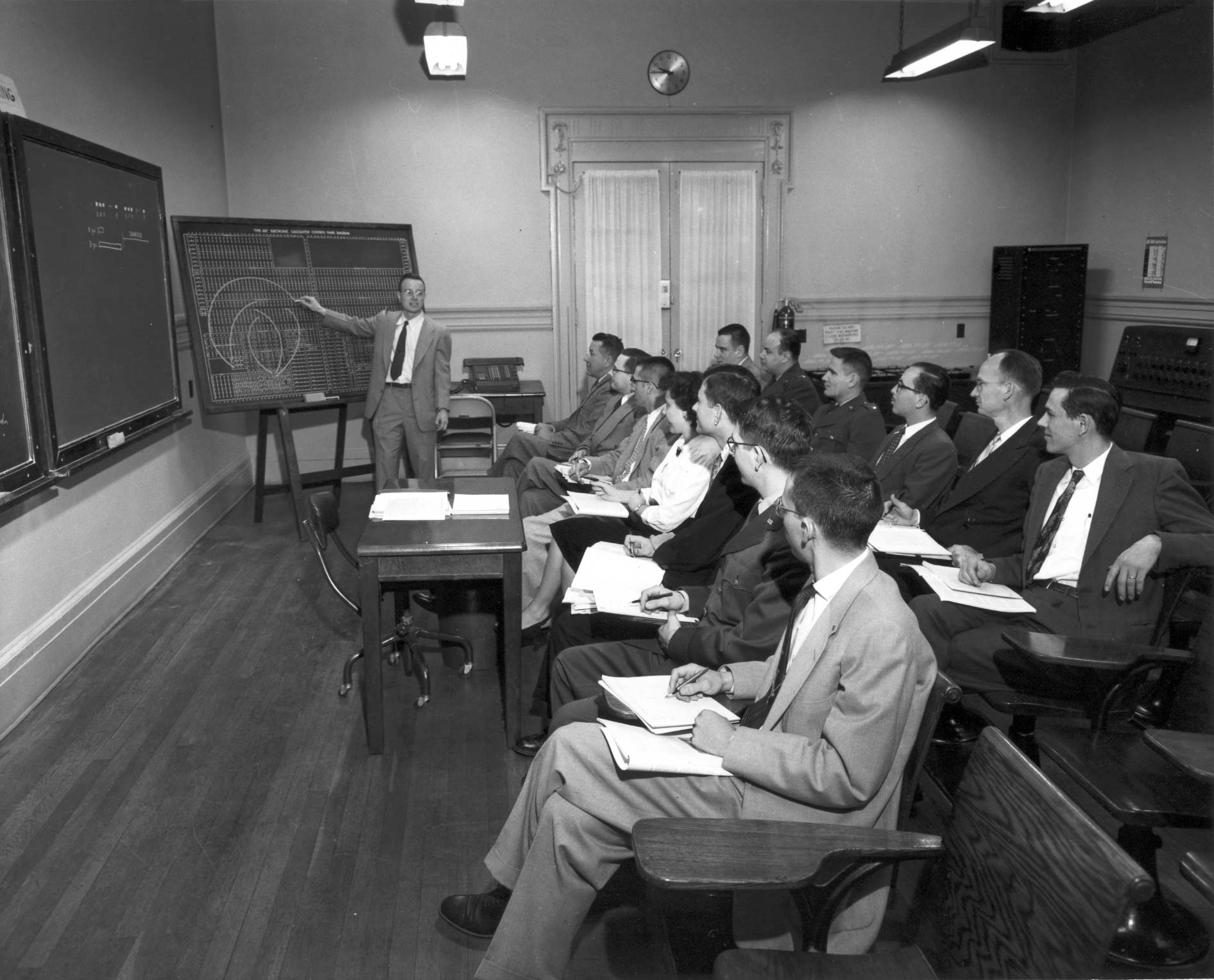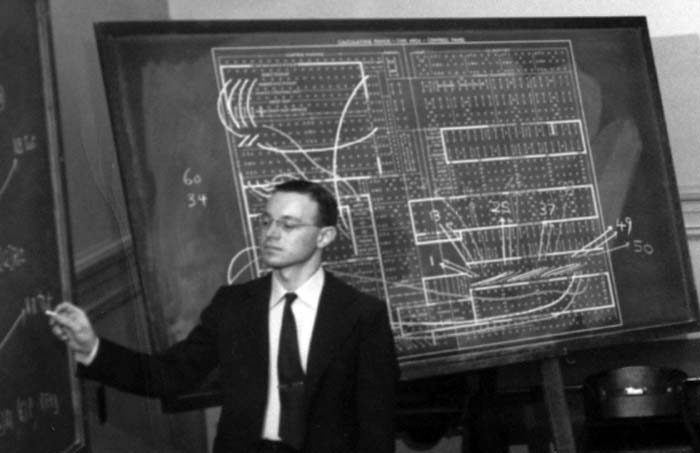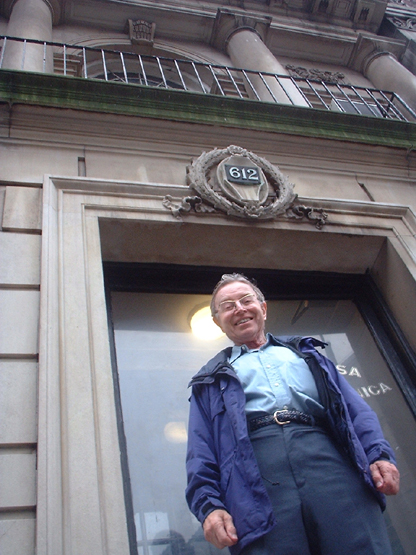The Watson Laboratory Three-Week Course on Computing 1947-1957

Eric Hankam teaching the Watson Laboratory Three-Week Course on Computing, in Watson Laboratory, Columbia University, 612 West 116th Street, New York City, about 1950.
The caption for a similar photo in the Brennan book [9] reads: "Eric Hankam, of the Watson Laboratory staff, conducted many classes in computing. A total of 1600 people from 20 countries came for instruction." Pictured: Eric draws wire connections on a blackboard embossed with an IBM plugboard template.
From the Brennan text: "By the end of November, 1945, the initial staff and equipment of the Watson Lab had moved into the renovated town house on 116th Street -- a relatively small building with space for about two dozen people and a computer room. Through its portals, nevertheless, there flowed a steady stream of scientists and students from all over the world, technical people from other industries and from government agencies, IBM sales representatives and their customers, users of the Lab's comprehensive technical library and various other visitors. A prime attraction was the provision of free time on the Laboratory's machines to any scientist or scholar engaged in research, subject to the approval of a Laboratory consulting committee. The great majority of these researchers, working in physics, economics, crystallography, engineering, optics, astronomy and many other fields, had little or no experience with IBM machines or with the application of computational techniques to the solution of problems. As a result, staff members in the early years of the Lab spent much of their time teaching people how to manipulate punch cards and get them through the machines. This effort was soon organized into group tutoring sessions -- such as one in which a group of research geophysicists from [Columbia's] Lamont Geological Observatory at Palisades, New York, were intensively "prepped" for a week. In 1947, the famous "Watson Laboratory Three-Week Course on Computing", taught by Eric Hankam of the Laboratory staff, was started. It was subsequently attended by about 1,600 people from over 20 countries. The course was also offered to high school mathematics and science teachers and to high school students in the New York metropolitan area.
"So great was the demand for admittance to Hankam's course that IBM eventually created computer instruction centers at various locations throughout the country, relieving Watson Lab of the task in 1957. To acquaint scientists around the world with advanced, large-scale computing methods, the IBM Department of Education had previously begun the practice of holding annual Scientific Computation Forums [such as the one in 1948]. Through the technical papers which they contributed to these forums, Watson Lab staff members reached a large audience of scientists who were interested in computing." [9]. (For some examples, see the Eckert bibliography.)
 Here are some closer views, showing different plugboard templates with wiring
connections in chalk. Since plugboards for different machines had different
layouts and configurations, a different template was needed for each
machine; hence the easel.
Here are some closer views, showing different plugboard templates with wiring
connections in chalk. Since plugboards for different machines had different
layouts and configurations, a different template was needed for each
machine; hence the easel.
 The blackboard in the left picture is labeled "TYPE 604 ELECTRONIC
CALCULATOR CONTROL PANEL DIAGRAM" (a Friden electromechanical calculator is
on the table at right). The blackboard in the right-hand photo is labeled
"CALCULATING PUNCH - TYPE 602-A - CONTROL PANEL".
The blackboard in the left picture is labeled "TYPE 604 ELECTRONIC
CALCULATOR CONTROL PANEL DIAGRAM" (a Friden electromechanical calculator is
on the table at right). The blackboard in the right-hand photo is labeled
"CALCULATING PUNCH - TYPE 602-A - CONTROL PANEL".

|
| Eric Hankam at 612 West 116th Street, 4 November 2003. Photo: Frank da Cruz |
Some of the early academic computing courses taught by Eckert, Thomas, and Grosch also included hands-on lab sessions with Eric and others [57], using the IBM 60x calculating machines.
- Homeward Bound, Eric Hankam's autobiography.
- Eric Hankam at IBM, summary of Eric Hankam's duties and accomplishments at IBM.
- Watson Laboratory Gallery.
- The IBM Watson Laboratory at Columbia University - A History by Jean Ford Brennan.
- Computer: Bit Slices from a Life by Dr. Herb Grosch.
Translations of this page courtesy of...
| Language | Link | Date | Translator | Organization or Link |
|---|---|---|---|---|
| Belarusian | Беларуская | 2023/08/22 | Vladyslav Byshuk | Владислав Бишук | studycrumb.com |
| Finnish | Suomi | 2023/08/31 | Kerstin Schmidt | https://writemyessay4me.org/ |
| French | Français | 2023/08/31 | Kerstin Schmidt | writemypaper4me.org |
| German | Deutsch | 2020/03/07 | Piotr Snuszka | BAS Business and Science GmbH, Berlin |
| Italian | Italiano | 2019/09/16 | Melanie Cohen | pFind |
| Italian | Italiano | 2023/08/31 | Kerstin Schmidt | https://admission-writer.com/ |
| Polish | Polski | 2023/08/31 | Kerstin Schmidt | https://prothesiswriter.com/ |
| Russian | Русский | 2023/08/22 | Vladyslav Byshuk | Владислав Бишук | skyclinic.ua |
| Spanish | Español | 2023/08/31 | Chema Bescos | Traducciones Zaragoza |
| Swedish | Svenska | 2023/08/31 | Kerstin Schmidt | justdomyhomework.com |
| Ukrainian | Українська | 2023/08/22 | Vladyslav Byshuk | Владислав Бишук | studybounty.com |